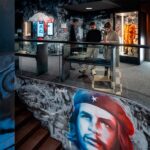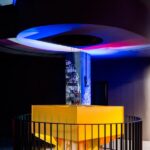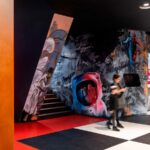Unveiling History: The Cold War Museum Berlin by Tchoban Voss Architekten

The Cold War Museum Berlin, inaugurated in November 2022, stands as a testament to history, nestled in the heart of Berlin-Mitte along the iconic Unter den Linden boulevard. Spanning two floors and encompassing over 1,600 square meters, this state-of-the-art museum, equipped with High-Tech Museum 4.0 features, offers a comprehensive exploration of the Cold War era from 1945 to the collapse of the USSR in 1991. Through interactive displays, virtual applications, and curated exhibits, the museum endeavors to make history accessible across generations.
Sustainable Design Approach
In the endeavor to create the exhibition architecture, sustainability and the reuse of existing building materials were paramount considerations. The museum found its home in a former office and commercial building, where the original spatial layout was largely retained. By repurposing the structure and integrating remnants of the previous fixtures, the design team minimized waste and upheld environmental responsibility. Regional sourcing of materials further emphasized the commitment to sustainability.

Symbolic Entry: The “Iron Curtain”
Visitors are greeted by a symbolic entry experience as they traverse through an “Iron Curtain,” conceptualized by Ukrainian artist Vanda Sakhatska. Comprising 20 steel elements, adorned with perforated portraits of notable Cold War-era figures, the installation juxtaposes the political landscape with depictions of ordinary citizens united under the peace symbol. The transition from the exterior is marked by a vibrant red floor, offering a stark contrast to the industrial steel above.
Immersive Exhibitions
The ground floor exhibition area beckons visitors with a chessboard-patterned floor, symbolizing the strategic maneuvers of the Cold War era. Interactive monitors, embedded within walls clad in rust-red patinated Corten steel, provide access to a wealth of multimedia content, including documentaries, photographs, and eyewitness accounts. Thematic graffiti, contributed by artists Enrico Mau and Fabian Brueckner, adds depth to the immersive experience, while virtual reality installations, such as Boris Hars-Tschachotin’s portrayal of Conrad Schumann’s daring escape, captivate the imagination.

Thematic Continuity
As visitors ascend to the upper floor, thematic continuity is maintained through a replica of a GDR room and iconic artifacts such as the Sputnik 1 satellite and the “Fat Man” atomic bomb. Elaborate graffiti adorning the staircase walls serves as a poignant reminder of the era’s complexity, culminating in a dual portrait of Nikita S. Khrushchev and John F. Kennedy, symbolizing the interconnectedness of opposing ideologies.
Reflective Conclusion
The Cold War Museum Berlin, through its meticulous curation and immersive design, offers visitors a compelling journey through one of the most defining periods of modern history. By repurposing existing structures and employing innovative storytelling techniques, Tchoban Voss Architekten has created a museum that not only educates but also inspires reflection on the enduring legacy of the Cold War era.





















